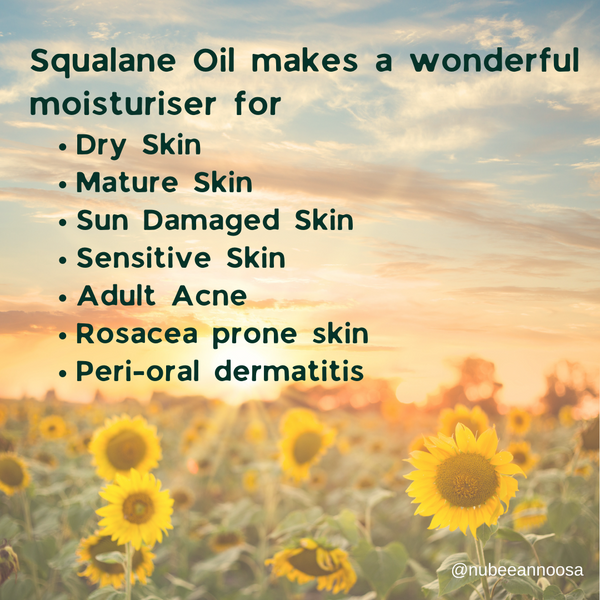Complete Guide to Squalane Oil for Skin - Benefits and Side Effects
Everything You'll Ever Need to Know About Squalane Oil
Squalane oil is a game changer for achieving beautiful, healthier skin, naturally. It deeply hydrates, restores and protects, leaving your skin looking and feeling soft, supple and radiant.
It really is like no other oil you’ve used on your skin before. As a skin nutritionist and naturopath, I’m going on record to say that it is simply THE VERY BEST moisturiser for all skin types.
Many people who are converting to natural skincare typically have either skin sensitivity to ingredients like preservatives & fragrances, or, they’re wanting cleaner, safer skincare without any red flag chemicals like parabens and phthalates. Often, they will turn to pure, natural and organic oils like Rosehip, Jojoba and Coconut oil as their day and night moisturiser.
The result for many, is quite simply, disappointing. Especially if you have skin that tends to be on the dry side, these oils just sit on the top of your skin and leave you feeling greasy but dry at the same time. Skin appears to age almost overnight as fine lines becomes more noticeable. By themselves these oils do very little to actually alleviate dry skin and do not really make effective moisturisers when used alone. Enter squalane.
In this guide to squalane oil, you’ll learn all about the benefits of this remarkable but mostly unknown oil. You’ll also discover the benefits of squalane for so many different skin problems including eczema, dry skin, peri-oral dermatitis, acne, fungal acne and eczema. By the time you’ve finished reading, you’ll understand why squalane is such a beloved oil for anyone wanting their skin looking and feeling its best with completely natural, clean and healthy skincare.
Sarah Luck
Nutritionist & Naturopath @NubeeanNoosa
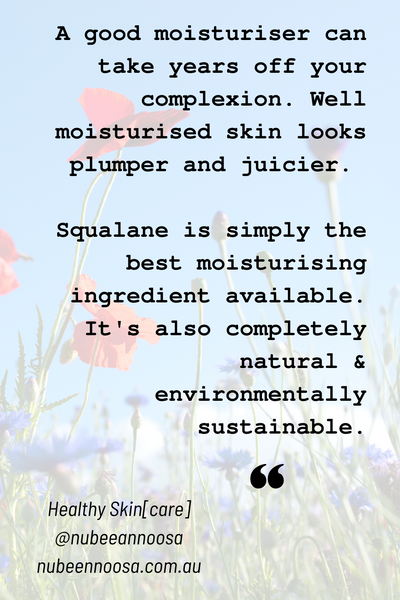
Properties of squalane oil
- Emollient
- Moisturising
- Hydrating
- Anti-inflammatory and anti-oxidant
- Promotes tissue repair and wound healing
Benefits of squalane oil
-
Hydrates skin
Squalane oil is a natural moisturiser that helps to keep your skin soft and hydrated by preventing moisture loss and bolstering your skins protective barrier. -
Non-comedogenic
Squalane oil does not block pores and cause breakouts. It is also safe for fungal acne. -
Reduces fine lines and wrinkle
By keeping skin well hydrated and moisturised, squalane has a plumping effect on dry and mature skin, helping to reduce the appearance of fine lines and wrinkles. -
Improves skin elasticity
Squalane oil helps to improve skin elasticity, creating a firmer and more radiant appearance. -
Absorbs quickly
Squalane oil is a light dry oil that is quickly absorbed into skin, leaving a non-greasy finish. -
Non-irritating
Squalane is a stable oil with a very low potential for allergy and irritation making it a great choice for anyone with skin sensitivity, allergy, eczema etc. -
Stable
Squalane oil is extremely stable and does not oxidise readily. Oils high in essential fatty acids are extremely fragile and oxidise easily when exposed to heat, light and oxygen. Oxidised oils are sources of free radicals which can damage skin cells, contributing to accelerated skin aging and other problems. Oxidised oils are bad for skin and trigger skin inflammation and irritation, increasing the risk of inflammatory skin conditions like acne and eczema. If your skin is already inflamed oils high in essential fatty acids can actually oxidise on your skin, leading to further irritation and inflammation! This happens because inflammation creates an environment that promotes oxidation.

What is squalane?
This section covers the biochemistry of squalane which can be a bit dry and boring. Feel free to skip to the next sections to discover the benefits of this remarkable, natural oil for your skin type.
If you've ever looked into squalane as an ingredient, you've likely come across the 'squalane vs squalene thing'. There's no way to make this information exciting, sometimes you just have to sum it up as short and sweet as possible.🤓
Squalane oil is produced from squalene. Squalene is a naturally occurring oil found in sebum (oil produced by your skin). Around 13% - 15% of your sebum is composed of squalene.
Squalene plays a critical role in keeping your skin hydrated and moisturised. It forms a protective barrier on the surface of your skin which helps to protect against environmental stressors and maintain the slightly acidic, natural pH balance of your skin. This acidic mantle helps to protect your skin against infection. Squalene is also a precursor for other important skin lipids called ceramides.
Ceramides are lipid molecules produced in your skin that are essential for a healthy skin barrier which prevents water loss and buffers your skin against UV radiation, pollution and infection from bacteria and other microbes. Reduced ceramide production causes dry, itchy and irritated skin which can lead to the development of eczema and dermatitis.
As you can see, squalene is kind of important for keeping your skin protected and naturally moisturised. Unfortunately, levels in your skin start to decline for many in their 20’s and 30’s and is one of the reasons for skin becoming dry and dull as we age. Sun exposure, hormonal changes, smoking, pollution, stress and diet all affect your skin’s production of squalene.
Squalane is a saturated version of the squalene produced in your skin.
The differences between them are important to biochemists, not your skin. Your skin will happily use squalane in place of squalene to produce ceramides and to keep your skin moisturised and hydrated – this is one of the important differences between squalane oil and other plant based oils like Rosehip and Jojoba.
There is one key difference between them that is worth understanding: squalane is highly stable and not prone to oxidising. Oxidised oils = free radicals. Squalene (produced by your skin) IS prone to oxidation which can be problematic for inflammatory skin conditions like acne and eczema.
TLDR: The whole squalane vs squalene thing can get confusing and it’s not really that important. The key thing to remember is that squalane oil is essentially identical to an oil produced naturally in your skin that assists with moisturising and keeping your skin barrier healthy. It also plays an important role in protecting against irritation and preventing water loss.
Who should use squalane oil?
Squalane is suitable for pretty much all skin types including newborns and the very elderly. Skin types that will benefit the most from squalane oil include:
- Dry skin
- Sensitive skin
- Mature skin
- Sun damaged skin
- Perioral dermatitis
- Acne prone skin
- Skin with a damaged barrier (eczema and dermatitis)
- Very elderly skin
- Inflamed skin
- Tretinoin (prescription retinol) and Accutane users
- Before and after skin treatments such as laser, chemical peel, microdermabrasion and micro needling
Squalane oil helps to bolster your skin’s own oil reserves and prevent water loss. Very oily skin doesn’t need squalane – it’s producing enough of its own oil. However, if you have very oily skin with dry patches, or have an inflammatory skin condition like acne, try using squalane as an oil cleanser for a few months as an 'oil exchange'.
Where does squalane used in skincare come from?
Squalane in skincare is created from squalene which is found naturally in certain plants (olives) and animals (shark livers). It can also be produced from sugarcane via bio-fermentation.
Sugarcane does not contain squalene or squalane, instead, sugar-cane pulp is bio-fermented with genetically modified yeast. The yeast feeds on the sugar cane and produce squalane as a by-product. Sugar-cane squalane is a naturally derived ingredient.
Squalane from olives is a 100% natural ingredient as it is derived directly from olive oil and is highly sustainable.

How can I use squalane oil?
Squalane oil can be used as both a highly effect moisturiser and oil cleanser - suitable for all skin types.
It makes a great base for serums due to its stability - it doesn’t oxidise or become rancid easily. This helps to keep active ingredients like vitamin C safe and protected from free radicals.
If you don’t want to use it in your daily skincare routine, try using it as a moisturising intensive skin treatment a few times a week.
Oil cleansers are an effective and gentle way to cleanse all skin types. Pure squalane can be used as an oil cleanser but it’s best mixed with other oils like Jojoba and fractionated Coconut oil.
For a medicated cleansing oil for skin prone to acne or inflammation (rosacea, eczema or psoriasis) squalane combines well with the powerful Ayurvedic oil Blackseed, also known as Nigella or Black Cumin Oil.
The Ultimate Guide to Black Seed Oil for Skin – Nubeean Noosa
Learn more about the benefits of oil cleansing and learn the right way to cleanse your skin with oil by reading our handy step-by-step guide to oil cleansing. There’s even a DIY oil cleanser recipe at the end that uses squalane oil.
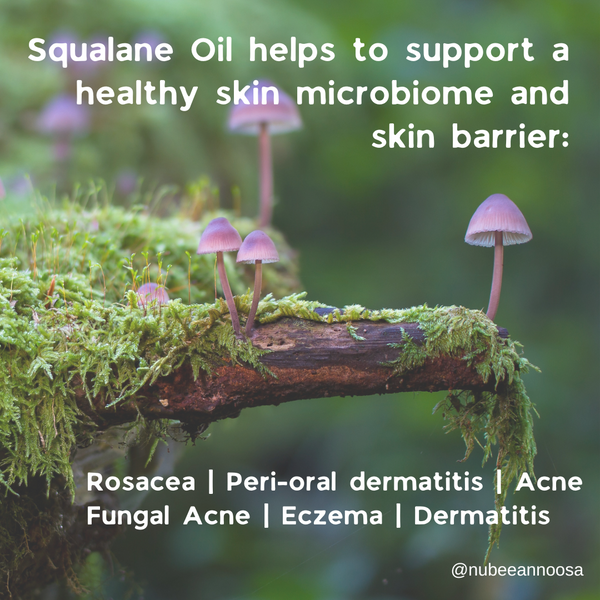
Squalane and acne
Higher levels of squalene in skin sebum have been linked to a higher risk of acne. In certain skin types, squalene (not squalane) fuels the growth of acne and skin inflammation causing bacteria, Cutibacterium acnes (formerly known as Propionibacterium acnes). It has been hypothesized that an increased percentage of squalene in acne prone skin may alter how sebum flows. Squalene is also easily oxidised, producing metabolites that can increase inflammation. More and more studies are emerging that show acne prone skin is susceptible to oxidative stress (free radical inflammation).
Squalane on the other hand does not oxidise readily, or, increase the growth of Cutibacterium acnes, making it perfect to use as a detoxifying oil cleanser for acne prone skin.
Squalane used as an oil cleanser will dissolve and remove any dirt, debris and excess sebum in your pores without stripping away your skin's protective barrier. If you have naturally oily skin, you probably won't need to use a moisturiser after oil cleansing with squalane - your skin will be left feeling clean, soft, hydrated and moisturised.
Squalane and fungal acne
Fungal acne is caused by an imbalance in your skin microbiome - the garden of bacteria and microbes that live on your skin and call it home. It's the result of an oil eating yeast that lives on skin called Malassezia. Unlike other yeasts, Malassezia does not feed on sugar or carbohydrates and as it lives on your skin, it won't respond to limiting these in your diet.
Fungal acne vs regular acne:
- Looks like small white bumps of the same size surrounded by red skin
- Usually appear in clusters
- Often itchy but not painful
- Worse with sweating
- Often flares in hot and humid temperatures
- More common in oilier areas - T-zone and hairline, back, chest, upper arms
It's important to note that you can have fungal and regular acne together at the same time!
Malassezia feeds on oils in your sebum and also loves to munch on many of the oils used in the majority of skincare products. In fact, it's easier to list the oils that ARE safe to use for fungal acne rather than oils to avoid. Safe oils that will not feed Malassezia yeast and worsen fungal acne are Squalane oil, fractionated coconut oil (MCT oil) and mineral oil. Squalane can be safely used as both a moisturiser and oil cleanser for fungal acne.
Squalane oil and dry skin
Squalane is highly moisturising, helping to hydrate and nourish dry and very dry skin. It’s easily and quickly absorbed to leave dry skin feeling soft and smooth. Squalane oil also has anti-inflammatory and anti-oxidant benefits which help to protect against many of the environmental factors that contribute to dry skin and can push naturally dry skin towards eczema, dermatitis and inflammation.
Due to its unmatched ability to deeply moisturise skin, squalane oil reduces the appearance of fine lines common to dry skin. It imparts a long lasting radiant glow to dry and very dry skin.
If you have dry or very dry skin, look for a product that contains a high percentage of olive squalane and use it regularly as part of your daily skincare routine.
Squalane and sun damaged skin
Whilst squalane does not possess any sun protection properties, it is still highly beneficial for sun damaged skin and plays an important role in helping to counter the accelerated aging that results from sun damage.
-
Hydration
Sun damaged skin is usually dry and dehydrated. UV radiation breaks down your skin’s natural barrier resulting in moisture loss and damage to skin lipids including ceramides and fatty acids. The result is dry, dull and dehydrated skin that is even more susceptible to further sun damage and accelerated aging. Squalane can help to replenish the decrease in natural skin oils caused by sun damage and repair your skin's protective barrier. -
Antioxidant
Sun exposure stimulates the production of free radicals. Free radicals are unstable molecules that damage skin cell function and break down your skin’s protective barrier. Free radical damage contributes to dryness, roughness and premature aging. With its antioxidant properties, squalane helps to protect skin from further free radical damage while it moisturises and hydrates. -
Anti-inflammatory
Sun damage triggers inflammation in your skin which creates a cascade of biochemical changes that promote accelerated aging and a decline in overall skin health. Squalane has anti-inflammatory properties which can help to quench skin inflammation. For best results, combine with other skin friendly antioxidants such as vitamin C and Niacinamide (vitamin B3)
Squalane can help to improve the appearance and general health of sun damaged skin, It is important to still take steps to protect your skin from further sun damage as the destructive and aging effects of UV radiation are cumulative.
Squalane and rosacea
Rosacea is an increasingly common skin condition that causes redness, flushing and visible blood vessels on your face. It also commonly results in a burning and itching sensation. Certain types of rosacea can also cause acne like breakouts. Whilst squalane does not specifically treat rosacea, its moisturising properties and mild, non-irritating nature make it beneficial if you have rosacea prone skin.
The underlying cause/s of rosacea are not completely understood but are likely a mix of genetic and environmental triggers that affect the skin microbiome and immune system. Your skin microbiome is the garden of bacteria and other microbes that call your skin home.
The antioxidant and anti-inflammatory properties of squalane oil can help to soothe and calm irritated skin and reduce redness. Its moisturising properties also help to manage dry, flaky skin – another common issue with rosacea prone skin
Whilst squalane will not cure rosacea, it’s an excellent moisturising and hydrating oil which can help to improve the appearance and health of skin as part of long term management of rosacea prone skin.
Squalane and peri-oral dermatitis
Perioral dermatitis is another skin condition resulting from an out of balance skin microbiome. It's characterised by red, bumpy and often scaly skin around the mouth that can feel burning, itching or sore. It can also affect skin around the nose, eyes, scalp and neck.
The following skincare ingredients should be avoided if you have perioral dermatitis: fragrances, preservatives, sulphates, alcohol, lanolin, heavy moisturisers and using makeup or cosmetics over the affected area.
The moisturising, anti-inflammatory, antioxidant and skin healing properties of squalane make it useful and beneficial as part of an ongoing comprehensive management plan for peri-oral dermatitis. It can be used as a moisturiser and oil cleanser. Look for products that contain a high percentage of olive squalane and use them regularly.
Squalane and mature skin
When it comes to the day-to-day care of mature skin, squalane shines brighter than other ingredient. There is quite simply, no other ingredient, natural or otherwise that has quite the same skin moisturising and hydrating benefits as squalane.
Squalane is the ideal moisturiser for mature skin. It’s also 100% natural and environmentally friendly. Its benefits include:
-
Hydration
Squalane improves skin hydration by supporting a healthier skin barrier, preventing moisture (water) loss through your skin. Hydrated skin looks plump and juicy compared to dehydrated skin which looks dull and lacking in vitality.
-
Protective Skin Barrier
Squalane strengthens your skins protective barrier. A damaged skin barrier leaks moisture and offers reduced protection against UV radiation, pollution, stress and even fluctuations in temperature. If your skin has a damaged barrier it will usually be more sensitive to skincare ingredients like fragrances and preservatives.
-
Fast Absorption
Light and non-greasy, squalane absorbs quickly into your skin. You can adjust the amount of squalane you use on your skin depending upon how naturally dry or oily it is.
-
Skin Elasticity
Squalane helps to improve skin elasticity and tone. For best results combine with ingredients that support healthy collagen metabolism like vitamin C and Niacinamide (vitamin B3). Squalane is also great when used alongside micro needling / derma rolling to support collagen health.
-
Non-Toxic and Non-Irritating
Low allergy and non-irritating properties make squalane a safe ingredient for even the most sensitive skin.
-
Anti-[premature]aging
Squalane has antioxidant and anti-inflammatory properties help to put the brakes on premature aging from free radicals and inflammation.
Squalane is best used daily to reap the full benefits for mature skin. Choose products that have a high percentage of squalane in them. Team with ingredients that are highly beneficial for mature skin: vitamin C, Niacinamide, Bakuchiol, Vitamin E and Retinol .
Squalane and eczema
Squalane is a great ingredient to use in the long-term management of eczema. Skin that is prone to eczema and dermatitis usually has a damaged skin barrier due to a combination of genetic and lifestyle factors. When the skin barrier is compromised it is unable to hold onto moisture (water), becoming dry, rough, dehydrated and itchy. Skin is also more prone to infection and inflammation.
Pure 100% squalane can be used as a moisturiser for the face and body for any adult or child with dry skin prone to eczema. It is a 100% natural and environmentally friendly alternative to petroleum derived oils (mineral oil). It’s low allergenicity also make it highly suitable for the daily management of eczema prone skin.
Apply squalane generously to damp skin after bath or shower. Allow 5 minutes to fully absorb into skin and apply more if needed over extra dry areas.
Squalane for hair and scalp
Squalane isn’t just amazing for your skin, it’s also a power ingredient for hair and scalp care. Squalane oil has the same benefits for your hair and scalp that it does for your skin: improved hydration, improved moisture control and protection.
It can be applied directly to the ends of your hair to smooth frizz and flyaways and improve shine and lustre. It’s a great natural alternative to silicones.
Dry, flaky, scaly and itchy scalp can be due to the same skin microbiome imbalance that causes fungal acne, overgrowth of the yeast Malassezia. This yeast is a common culprit behind many scalp issues. Malassezia feeds on the oils produced by your hair follicles, producing waste products that cause inflammation and irritation.
Squalane can be applied regularly to dry, itchy and scaly scalps as a moisturiser. It combines well with salicylic acid for improving scalp health and black castor oil to help improve nutrition and circulation to hair follicles.
Squalane does not feed Malassezia yeast which is responsible for dandruff, flaky, itchy and scalp scalp conditions.This makes squalane the ideal oil to use for moisturising dry, itchy and irritated scalps. It acts as an oil cleanser on your scalp, helping to remove scalp oils and dead skin which feed Malassezia.
Apply squalane directly to dry, irritated and flaky scalps using a tint brush.
Because squalane is absorbed quickly into your scalp you can team it with Rosemary Oil and Black Castor Oil to promote thicker, healthier hair growth. It will soak into your scalp and take the active oils with it to nourish your hair follicles and stimulate circulation to deliver extra nutrients and remove cellular wastes.
How to use squalane oil Australia
How much squalane you use will depend upon how dry or oily your skin is. Very dry skin will require much more than oily skin. You’ll quickly learn the perfect amount for you skin.
Start by apply a small amount and waiting 5 minutes for it to soak completely into your skin. After 5 minutes, wipe any excess from your skin, or, if your skin still feels dry, apply a little more. Dry and very dry skin will drink in squalane very quickly – keep applying until your skin does not absorb any more. The result will be deeply moisturised skin with a radiant glow.
One of squalene’s most important functions is to keep moisture (water) locked into your skin to prevent dehydration. Squalane is best applied to skin that is still damp from cleansing or after applying toner. You can also keep a high quality filtered mineral water in a spray bottle to spritz your skin with before applying squalane.
Squalane side effects
Squalane is one of the safest skincare ingredients, natural or man-made. The qualities that make squalane such a wonderful low-tox and low allergy skincare ingredient include:
- Stable - squalane does not oxidise easily. Oxidised oils are also known as rancid oils and are a source of free radicals which accelerate skin aging.
- Low allergy - squalane is a very low allergy oil. Its low allergy potential makes it a great natural alternative to mineral oil for sensitive, dry or atopic skin.
- Skin barrier - squalane works on repairing the skin barrier. A damaged or dysfunctional skin barrier is a common problem in anyone with sensitive, reactive or allergic skin.
- Skin microbiome - Squalane does not disrupt your skin microbiome (the garden of bacteria and microbes that live upon your skin). An out of balance skin microbiome makes your skin's immune system cranky and irritated.
That doesn't mean that squalane is going to be safe for everyone. Low allergy doesn't mean no allergy.
If you have extremely sensitive skin or suffer from mulitple allergies and intolerances, always test patch test a small area of skin first. Start by applying to the skin inside your elbows for a few nights, then apply under your chin and behind your ears before trying it on your face.
The following are the most common reactions that I have come across in the many years that I have used, recommended and talked with people about squalane. These reactions are uncommon but can be alarming if you have sensitive skin, in most cases they are temporary and disappear after an adjustment period.
-
A peppery feeling - squalane can very rarely cause a slight peppery feeling in your skin when first applied. In most cases this is a skin sensation and not an allergic reaction. It usually disappears after a few days of use. An allergic reaction usually feels hot and inflamed and continues to worsen, whereas the peppery sensation from squalane only lasts 15-20 minutes after first applying. Applying squalane to very damp skin and then a second application 5-10 minutes later often resolves the problem. I cannot find a good reason to explain this reaction, but I have noticed that it is more common in skin with a damaged barrier and hypersensitive skin. Facial skin is rich in sensory nerve endings, and it may be that either squalane itself interacts with some of these nerves, or, the instant moisturising effect of squalane upon skin creates this sensation. A dermatology study from the late 90's found that hydration levels can alter skin sensation. Squalane significantly improves skin hydration.
- Breakouts (acne) - squalane can cause breakouts if you are not cleansing your skin properly. Exfoliation is an important part of healthy skincare. It removes dead surface skincells and allows oil to flow freely. Allowing dead surface skin cells to build up and then adding in more oil can cause temporary pimples. The answer is to exfoliate at least 3 x weekly using a chemical exfoliant (salicylic acid, lactic acid or glycolic acid) or a manual exfoliant (raw honey, almond meal, rice bran, konjac sponge, microfibre cloth etc)
Squalane also enhances the absorption of other chemicals and products applied to your skin. Some reactions may be due to enhanced absoprtion of other chemicals or ingredients mixed with squalane or used on skin at the same time, especially fragrances and preservatives.
Squalane and Healthy Skincare
Squalane oil from olives is a completely natural oil that is light and highly moisturising for all skin types. It is sustainable, environmentally and ecologically friendly and a valuable best-for-skin ingredient in natural skincare.
It has no smell and is very stable, giving it a long shelf life without the need to add in synthetic antioxidants to preserve it. Its stability also helps it to protect other less stable active ingredients such as vitamin C, retinol and Bakuchiol.
It can be used as a pure oil, as a serum moisturiser or oil cleanser. There is no need to use other moisturisers while using squalane oil.
Look for natural products that contain a high % of squalane oil for best results and a long shelf life.
If you’ve enjoyed this in depth review of squalane oil and you’re feeling inspired to experience squalene’s moisturising, hydrating and protective benefits, please consider sharing this article on social media to help educate and create more awareness of this 100% natural, environmentally friendly, low tox and most importantly, highly effective skincare ingredient (with the weird sounding name!)
Learn more about squalane oil
Squalene and Squalane.pdf (cir-safety.org)
Moisturizers: The Slippery Road - PMC (nih.gov)
Biological Importance and Applications of Squalene and Squalane - ScienceDirect
ETC_spices_CSonly_sept2016.qxd (synbiowatch.org)
The Role of Moisturizers in Addressing Various Kinds of Dermatitis: A Review (clinmedres.org)
Squalene Stimulates a Key Innate Immune Cell to Foster Wound Healing and Tissue Repair (hindawi.com)
If you're looking to try squalane oil and would like to support an Australian business, you may be interested in the following products:
100% Pure Olive Squalane Oil
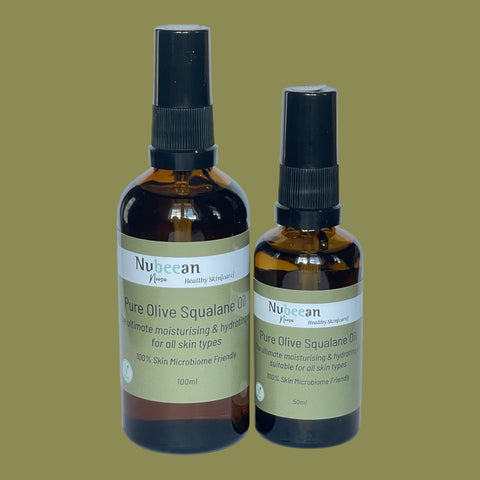
Pure squalane oil from olives. Makes a wonderul, safe and natural moisturiser for all skin types. Can be used on the whole body, scalp and face. Suitable for newborn babies and the fragile skin of the very eldery and every skin type in between.
Moisturising Balm for Extra Dry Skin
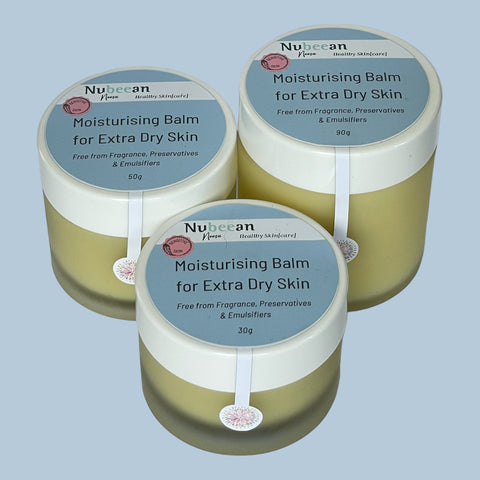
Pure Olive Squalane oil blended with Noosa Hinterland Beeswax, natural vitamin E and organic Jojoba oil. Use on face, body and hands. Use as a moisturising mask a few times per week. Extremely moisturising, hydrating and occulusive.
Vitamin C Serums in Pure Squalane Oil
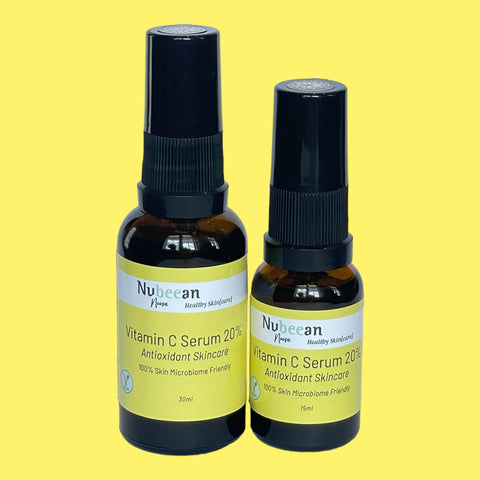
Pure squalane mixed with vitamin C (tetrahexyldecyl ascorbate). Availabe in 10%, 20% and 30% strength.
Plant-based Retinol Alternative in Pure Squalane Oil

Bakuchiol, a 100% natural plant based retinol alternative + vitamin C in pure olive squalane oil. Safe for use during pregnancy and breastfeeding.
BlackSeed & Kunzea Cleansing Oil

A "medicated" oil that can be used as an oil cleanser as well as leave on skin and scalp treatment. Pure olive squalane blended with organic BlackSeed oil and Kunzea oil.
Blue Tansy Serum
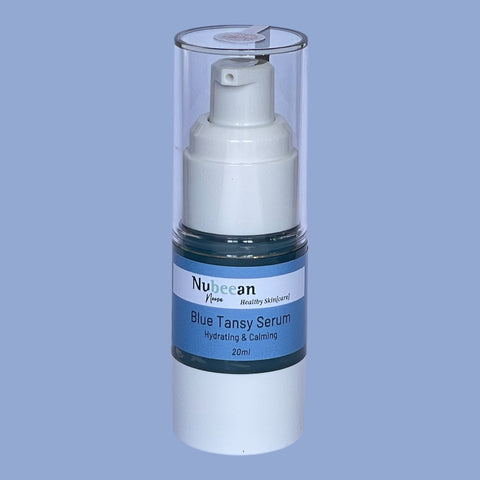
Contains a very high percentage of squalane oil blended with virgin Blueberry Seed Oil, Blue Tansy Oil and Noosa Hinterland Beeswax. A calming and hydrating moisturising serum for dry & mature skin. Helps to reduce redness and feelings of heat and irritation.
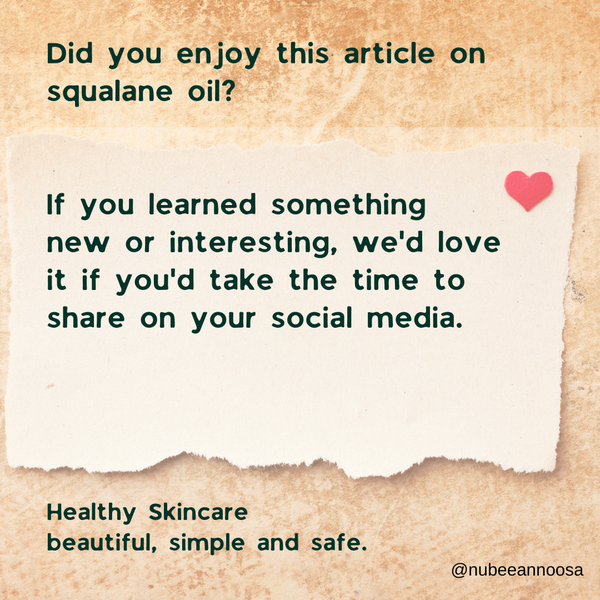
Do you know someone that you think might benefit from using squalane oil on their skin? Why not share this article with them via email or social media?
Do you have a story to share about squalane oil? Leave a comment below.
 Skip to content
Skip to content

